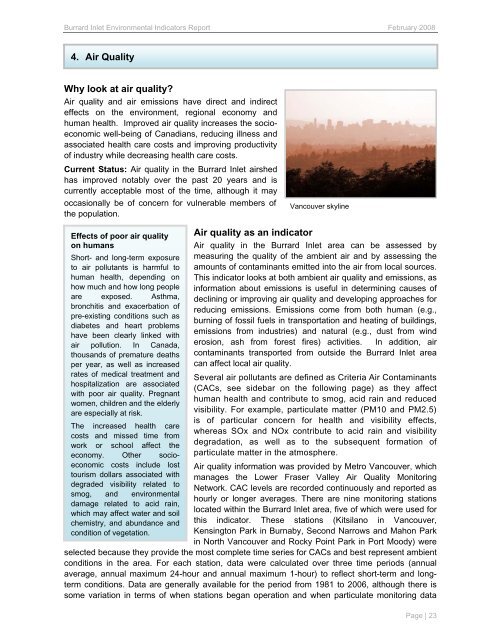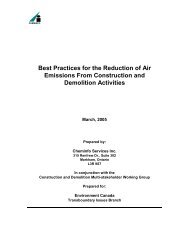Burrard Inlet Environmental Indicators Report - the BIEAP and ...
Burrard Inlet Environmental Indicators Report - the BIEAP and ...
Burrard Inlet Environmental Indicators Report - the BIEAP and ...
Create successful ePaper yourself
Turn your PDF publications into a flip-book with our unique Google optimized e-Paper software.
<strong>Burrard</strong> <strong>Inlet</strong> <strong>Environmental</strong> <strong>Indicators</strong> <strong>Report</strong> February 2008<br />
4. Air Quality<br />
Why look at air quality?<br />
Air quality <strong>and</strong> air emissions have direct <strong>and</strong> indirect<br />
effects on <strong>the</strong> environment, regional economy <strong>and</strong><br />
human health. Improved air quality increases <strong>the</strong> socioeconomic<br />
well-being of Canadians, reducing illness <strong>and</strong><br />
associated health care costs <strong>and</strong> improving productivity<br />
of industry while decreasing health care costs.<br />
Current Status: Air quality in <strong>the</strong> <strong>Burrard</strong> <strong>Inlet</strong> airshed<br />
has improved notably over <strong>the</strong> past 20 years <strong>and</strong> is<br />
currently acceptable most of <strong>the</strong> time, although it may<br />
occasionally be of concern for vulnerable members of<br />
<strong>the</strong> population.<br />
Effects of poor air quality<br />
on humans<br />
Short- <strong>and</strong> long-term exposure<br />
to air pollutants is harmful to<br />
human health, depending on<br />
how much <strong>and</strong> how long people<br />
are exposed. Asthma,<br />
bronchitis <strong>and</strong> exacerbation of<br />
pre-existing conditions such as<br />
diabetes <strong>and</strong> heart problems<br />
have been clearly linked with<br />
air pollution. In Canada,<br />
thous<strong>and</strong>s of premature deaths<br />
per year, as well as increased<br />
rates of medical treatment <strong>and</strong><br />
hospitalization are associated<br />
with poor air quality. Pregnant<br />
women, children <strong>and</strong> <strong>the</strong> elderly<br />
are especially at risk.<br />
The increased health care<br />
costs <strong>and</strong> missed time from<br />
work or school affect <strong>the</strong><br />
economy. O<strong>the</strong>r socioeconomic<br />
costs include lost<br />
tourism dollars associated with<br />
degraded visibility related to<br />
smog, <strong>and</strong> environmental<br />
damage related to acid rain,<br />
which may affect water <strong>and</strong> soil<br />
chemistry, <strong>and</strong> abundance <strong>and</strong><br />
condition of vegetation.<br />
Vancouver skyline<br />
Air quality as an indicator<br />
Air quality in <strong>the</strong> <strong>Burrard</strong> <strong>Inlet</strong> area can be assessed by<br />
measuring <strong>the</strong> quality of <strong>the</strong> ambient air <strong>and</strong> by assessing <strong>the</strong><br />
amounts of contaminants emitted into <strong>the</strong> air from local sources.<br />
This indicator looks at both ambient air quality <strong>and</strong> emissions, as<br />
information about emissions is useful in determining causes of<br />
declining or improving air quality <strong>and</strong> developing approaches for<br />
reducing emissions. Emissions come from both human (e.g.,<br />
burning of fossil fuels in transportation <strong>and</strong> heating of buildings,<br />
emissions from industries) <strong>and</strong> natural (e.g., dust from wind<br />
erosion, ash from forest fires) activities. In addition, air<br />
contaminants transported from outside <strong>the</strong> <strong>Burrard</strong> <strong>Inlet</strong> area<br />
can affect local air quality.<br />
Several air pollutants are defined as Criteria Air Contaminants<br />
(CACs, see sidebar on <strong>the</strong> following page) as <strong>the</strong>y affect<br />
human health <strong>and</strong> contribute to smog, acid rain <strong>and</strong> reduced<br />
visibility. For example, particulate matter (PM10 <strong>and</strong> PM2.5)<br />
is of particular concern for health <strong>and</strong> visibility effects,<br />
whereas SOx <strong>and</strong> NOx contribute to acid rain <strong>and</strong> visibility<br />
degradation, as well as to <strong>the</strong> subsequent formation of<br />
particulate matter in <strong>the</strong> atmosphere.<br />
Air quality information was provided by Metro Vancouver, which<br />
manages <strong>the</strong> Lower Fraser Valley Air Quality Monitoring<br />
Network. CAC levels are recorded continuously <strong>and</strong> reported as<br />
hourly or longer averages. There are nine monitoring stations<br />
located within <strong>the</strong> <strong>Burrard</strong> <strong>Inlet</strong> area, five of which were used for<br />
this indicator. These stations (Kitsilano in Vancouver,<br />
Kensington Park in Burnaby, Second Narrows <strong>and</strong> Mahon Park<br />
in North Vancouver <strong>and</strong> Rocky Point Park in Port Moody) were<br />
selected because <strong>the</strong>y provide <strong>the</strong> most complete time series for CACs <strong>and</strong> best represent ambient<br />
conditions in <strong>the</strong> area. For each station, data were calculated over three time periods (annual<br />
average, annual maximum 24-hour <strong>and</strong> annual maximum 1-hour) to reflect short-term <strong>and</strong> longterm<br />
conditions. Data are generally available for <strong>the</strong> period from 1981 to 2006, although <strong>the</strong>re is<br />
some variation in terms of when stations began operation <strong>and</strong> when particulate monitoring data<br />
Page | 23
















